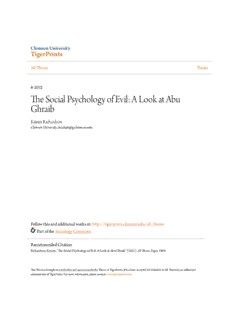
The Social Psychology of Evil: A Look at Abu Ghraib PDF
Preview The Social Psychology of Evil: A Look at Abu Ghraib
Clemson University TigerPrints All Theses Theses 8-2012 The Social Psychology of Evil: A Look at Abu Ghraib Kristin Richardson Clemson University, [email protected] Follow this and additional works at:https://tigerprints.clemson.edu/all_theses Part of theSociology Commons Recommended Citation Richardson, Kristin, "The Social Psychology of Evil: A Look at Abu Ghraib" (2012).All Theses. 1469. https://tigerprints.clemson.edu/all_theses/1469 This Thesis is brought to you for free and open access by the Theses at TigerPrints. It has been accepted for inclusion in All Theses by an authorized administrator of TigerPrints. For more information, please [email protected]. THE SOCIAL PSYCHOLOGY OF EVIL: A LOOK AT ABU GHRAIB A Thesis Presented to the Graduate School of Clemson University In Partial Fulfillment of the Requirements for the Degree Master of Science Applied Sociology by Kristin Lynn Richardson August 2012 Accepted by: Dr. William Wentworth, Committee Chair Dr. Kinly Sturkie Dr. Sarah Winslow ii ABSTRACT In the spring of 2004, the military police assigned to guard the Abu Ghraib prison in Baghdad, Iraq found themselves at the center of numerous investigations regarding the abuse, torture, rape, and murder of detainees in United States custody. Their behavior was influenced and encouraged by U.S. officials, including President George W. Bush and Secretary of Defense Donald Rumsfeld. The Bush administration effectively created a reality for the military police that fostered increasingly violent and aggressive tendencies beyond what is expected or allowed in similar circumstances. Existing literature and conclusions from previous studies support the claim that social and situational forces can influence individuals to commit cruel and unusual acts while under the authority of a legitimated institution or figure. The obedience studies conducted by Stanley Milgram and Philip Zimbardo’s Stanford Prison Experiment provide empirical evidence of the social psychological theories of the social construction of reality, impression management, and the Thomas Theorem. I explore the story of Abu Ghraib through the lens of symbolic interactionism via the qualitative data collection process of content analysis. Government documents such as interrogation procedures defined by the U.S. Army and memorandums prepared, issued, and (sometimes) rescinded by government officials in the months leading up to the investigations regarding detainee treatment and interrogation at Abu Ghraib is included in the content analysis. Other materials included consist of the photographs, newspaper articles, iii and documentaries that engulfed the media during and after the investigations, as well as the official expert investigation reports and detainee and eyewitness account depositions and interviews. A careful examination of the materials in the content analysis reveal a striking resemblance to the empirical studies listed above, supporting the claim that situational factors created a reality the guards considered to be real and (as the Thomas Theorem predicts) became real in its consequences. iv DEDICATION This thesis is dedicated to the past, present, and future generations of brave men and women who proudly serve our country in all branches of the United States military. Their commitment, courage, loyalty and sacrifice deserve the utmost respect, endless appreciation, and highest admiration. v vi ACKNOWLEGDGEMENTS I would like to express my deepest gratitude to Dr. William Wentworth, my thesis chair, for his assistance in writing this manuscript. His advice and expertise has been of incalculable value throughout this process. I would also like to thank Drs. Douglas K. Sturkie and Sarah Winslow for their guidance and support in the preparation, construction, and completion of my thesis. The confident, supportive, and encouraging environment created by the members of this thesis committee served as reassurance and inspiration for my success. I am also grateful to the remainder of the faculty in the Department of Sociology and Anthropology at Clemson University for their assistance in helping me achieve the Master’s degree in Applied Sociology. vii viii
Description: